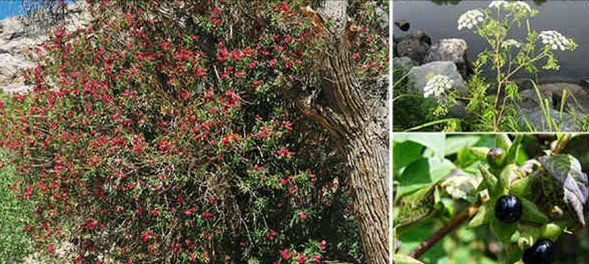Plant Awareness from the Field of Master Mind Survival (MMSUR)
Shared from the research of: Joseph Mercado
Article Author: K.J. Barber – Ask A Prepper
To: Survivalist
Blog Post #721
Re: Deadly Backyard Plants
Date and Time: Tuesday, June 4, 2019 at 11:00 p.m.
Dear Survivalist,
Colorful landscaping in our yards can be rather stunning, both natural and intentionally planted. From the bright blooms, to the healthy green sprawling throughout our surroundings, sometimes the view can’t be beat.
However, don’t let the beauty fool you. Turning the backyard into your personal botanical garden carries potential for significant risk. The levels of toxicity in some plants can be life-threatening to pets and humans alike.
So, before venturing out for a stroll in the fields, or making plans for landscaping your yard, you should be aware of the dangerous plants that could harm or kill pets and humans. Or, maybe some of these plants already exist in your surroundings.
1. Oleander
Oleander has established its way into many residential gardens, due to the appearance. It is most commonly found tropical and subtropical areas, around streams, rivers, and valleys.
In the US, it’s normally found in the southern region.
It typically occurs around stream beds in river valleys, where it can alternatively tolerate long seasons of drought and inundation from winter rains. Nerium oleander is planted in many subtropical and tropical areas of the world. On the East Coast of the US, it grows as far north as Virginia Beach, Virginia, while in California and Texas miles of oleander shrubs are planted on median strips.[
Despite its appeal of colorful and fragrant blossoms, the entire plant contains a deadly substance, which can lead to vomiting, drowsiness, seizures, and slow down the heart.
Treatments might include activated charcoal or a tube inserted in the stomach to flush the system, as well as oxygen and medicines to treat the symptoms.
2. Daffodil
The Daffodil is bright and colorful flowering plant. And, it’s found in most regions within the US, except in areas that rarely see a frost. The bulbs thrive best with cold hibernation periods.
As beautiful as they can be, it’s a poisonous plant, especially the bulb. Symptoms of daffodil poisoning include stomach pain, drooling, vomiting, heart irregularities, tremors, and convulsions. Simply having a bouquet indoors can trigger headaches.
Unless the symptoms are severe, they will often go away with a flushing of water or milk.
3. Water Hemlock
The water hemlock plant is another deceptive and innocent looking plant. Its dainty appearance, with small and frail-like white buds and a distinct umbrella-like shape, will have you believing it’s harmless.
Water Hemlock is commonly found in North America and Europe within pastures, and wet soils such as water edges and irrigation canals.It’s perhaps one of the most toxic plants.
It contains a brownish liquid called cicutoxin and can be deadly. It’s found primarily in the root, but also within the entire plant. This toxin will attack your central nervous system, and has been known to trigger convulsions.
If ingestion is caught early, activated charcoal would be the initial treatment. However, there isn’t any specific antidote, just treatment to help control seizures. This might include benzodiazepines, or a barbiturate to help manage seizures.
4. Hellebore
Hellebores are widely grown in gardens in the US zones 5a to 8b, for their decorative traits. It’s a stout plant with some varieties reaching up to 7ft tall when fully grown and blooming. Many gardeners like hellebore because their flowers bloom during the winter and early spring, and are resistant to frost.
While cases of poisoning from a hellebore plant are rare, it’s most likely due to gardeners handling them with care. The entire plant, from roots to tip of the leaves, is poisonous to both human and animals. The seeds of the plant contain cevadine and veratridine, and considered to be toxic.
Symptoms of poisoning from the hellebore plant include vomiting, paralysis, loss of eyesight, or a catharsis effect, which could lead to death. Seek medical attention immediately if you have any of these symptoms after encountering any part of the plant.
5. Poison Ivy
The name even says it’s poisonous. It’s a nuisance to many, but dangerous to some.
It can cause symptoms ranging from a mild rash, to dangerous swelling in the eyes, mouth, and airway for people who are allergic to it and breathe in toxic smoke when someone is burning it.
Predominantly found in North America, it’s not a plant that people plant and grow intentionally. It’s like the obnoxious cousin that makes surprise and unwanted visits.
If you have been exposed to the plant, you might be able to avoid a rash or outbreak by washing up with soap and cold water. Never use hot water though, which will open the pores and allow the oils to penetrate further. If a rash occurs, a diphenhydramine or calamine lotion will help mitigate mild symptoms. In a severe reaction, seek medical attention because further treatment such as corticosteroids might be necessary.
6. Lily of the Valley
Originating in the Northern Hemisphere of Asia and Europe, it’s a hardy plant which allows it to flourish in zones 2-9.
It has a delicate and sweet appearance with dainty bell-shaped petals, but it’s deceiving. If any part of the plant is ingested, it can bring on flu like symptoms such as diarrhea, vomiting, and fatigue. In severe cases, it is known to bring on mental confusion and an irregular heartbeat.
Treatments might include flushing the system through activated charcoal or laxatives.
7. Belladonna
Also known as “deadly nightshade”, belladonna is native to North Africa, Europe, and Western Asia. It has since been distributed to Great Britain, parts of the Ukraine, Iran, and North America.
It tends to grow on the edge of forests, river banks, and roads.
The attractive berries and foliage contain tropane alkaloids making them extremely toxic and deadly when ingested. It is perhaps one of the deadliest plants that a person can have in their backyard.
Symptoms appear within 20 minutes and include breathing difficulty, swelling, rash, nausea, vomiting, blue lips, disorientation, and convulsions.
If digested, induce vomiting and seek medical treatment immediately.
Content Source: AskAPrepper.com

![]()
Have a question about this blog post?
Please send us an email message below and we will serve you with an answer momentarily.



